page 18
Note: the contents of this page as well as those which precede and follow, must be read as a continuation and/or overlap in order that the continuity about a relationship to/with the dichotomous arrangement of the idea that one could possibly talk seriously about peace from a different perspective as well as the typical dichotomous assignment of Artificial Intelligence (such as the usage of zeros and ones used in computer programming) ... will not be lost (such as war being frequently used to describe an absence of peace and vice-versa). However, if your mind is prone to being distracted by timed or untimed commercialization (such as that seen in various types of American-based television, radio, news media and magazine publishing... not to mention the average classroom which carries over into the everyday workplace), you may be unable to sustain prolonged exposures to divergent ideas about a singular topic without becoming confused, unless the information is provided in a very simplistic manner.
Let's face it, humanity has a lousy definition, accompanying practice, and analysis of peace.
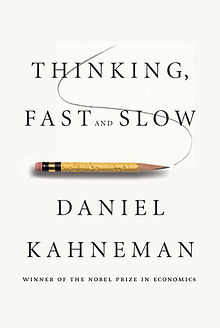
There are numerous models of dichotomy which can be used to at least suggest the existence of an underlying thinking pattern that continues to crop up and has done so for centuries, albeit with different labels and applications. One of these is represented in the book entitled "Thinking, Fast and Slow" (2011) by Daniel Kahneman which was an intended lay-person's outline of the article "Prospect Theory: An Analysis of Decisions Under Risk" (1979), which he and Amos Tversky had worked on. Since the book is focused on the application of psychology to thinking in terms of economic decisions and the Peace/War (conflict) dichotomy does revolve around many economic questions (costs, funding procurement, political stratifications of diplomacy, etc...); a closer look at the model is needed to see if it can render any useful insights into our serious look at Peace.
Kahneman and Tversky did not produce an altogether new, that is... original idea. The dichotomy of "fast and slow" is an old "Dick and Jane see spot run" type of illustration representing more complex terms and ideas, and yet omits the inclusion of more basic and simple ideas such as might be described as up/down, in/out, here/there, hot/cold, yes/no, etc..., with a particular emphasis to denote the overlooked regurgitation of a good/bad or good/evil theme. Hence, there is some value in pointing out that the "2-system" formula is not new, and the Wikipedia article on "Dual Process Theory" describing William James as the originator of the foundations of dual process theory... is a Western bias, when the belief system of Yin and Yang clearly represents a dual process theory though other perspectives involving simpler dualities no doubt predate the Yin and Yang formulation since physiology influences the construction of extreme points of referencing (such as hot and cold), though the "middle ground or middle way" may not be an articulated nor assigned a "happy medium" label, though the position is highly sought after. However, Western minds like to lace and embellish basic ideas to give the impression of having created something original and monumental.
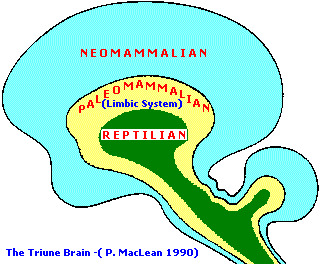
It is surprising to find so many educated people indulging in the usage of a two-patterned schema of reasoning related to human thought processing that is subsequently applied to economics, behaviorism and sociological dimensions of analysis. It's as if they never heard of, ignore or are dismissive of the idea of a generalized three-brain structural format denoted by Paul MacLean in his triune brain hypothesis. Nor do they seem to perceive the importance of hearing and its direct connection to the brain and that some sounds are transmitted through the bones such as the jaw and skull. If hearing were not so important in the development of language and subsequent ideation, it could be dispensed with. No less, the ear is considered to be a part of the brain and may, for the discussion at hand, be analogically considered to be a brain division... or at least a vital extension thereof. However, it is of interest to point out though the processing of sounds in the form of words is through a mechanism involving a multiplicity of three-patterned structural arrangements, so many two-patterned ideas are generated... by so many people... and only a few come to appreciate on a non-theological or numerological reference to patterns-of-three. (See page 2 for a reference to structural components of the ear.)
Using the "fast and slow" terminology, the insistence on using a two-patterned thinking reference as opposed to a three-patterned thinking reference, suggests that such ideas were developed in the fast lane of thinking that the slow brain attempted to label but was too slow to engage the fast brain with its impulsivity to marginalize the tortoise brain by effecting a race course along a pathway of scenic ideas that would enable the hare to become a prominent figure to spectators who are already mentally primed to expect and desire speed over diligence. In other words, though the dual process theory, and hence... the "Thinking, Fast and Slow" are already favoured by the larger human audience of participating spectators in that they represent basic structural formulas easily identifiable on a simplistic level of understanding; they will win at the race of consideration before all the votes have been counted, just like the rigged Electoral College voting system. In other words, thinking about thinking is a rigged system favoring a two-patterned formulation because it assists the reigning aristocracy of researchers and philosophers to maintain their dominance. Not only is the political systems throughout the world rigged, but so are theoretical and philosophical foundations. Most favor a two-party system that may permit the exercise of a third idea, so long as it remains a negligible consideration to be used to substantiate a two-party, or two-position formula like that of the Peace/War (conflict) circumstance.
Trying to present a new idea concerning the traditionalized two-patterned Peace/War perspective is very much like trying to introduce a third party into a two-party dominant system... much less trying to introduce a threesological theory into an arena with a social layout architectured for a two-opponent contest. When we have thousands upon thousands of people who remain either a Republican or Democrat for life, or hold a defined Right or Left political designation, or think in terms of good/evil, right/wrong, legal/illegal, rich/poor, smart/dumb, strong/weak, pretty/ugly, etc..., how does a three-part ideology break ground through any shoe-horning process, if the larger social system... with its many two-pattern created errors; institute an observance of disallowing participation by engaging in tactics to undermine, be dismissive of, attack, ostracize, disenfranchise, and otherwise develop on-the-spot methods of exclusion if need be? When we have a system geared to the usage of a perspective which utilizes a two-patterned Peace/War or other dual-processing orientation, how do we improve upon the dysfunctionality without engaging in a Revolution because the system is made to exclude new-comers... because it is actively prejudicial, discriminatory and segregationist in form, function and culturally predisposed to do so? In short, dual process theory is another example of a long list of Bias-related concepts, most of which do not become entered into conventional lists of academians because of context driven inter-related personalized specificities. Nonetheless, a forthcoming list will give the reader some small idea of different biases.
From the Wikipedia Dual Process Theory article we find the following Comments followed by a representative table of two-patterned listings:
|
Dual-process accounts of reasoning The dual-process accounts of reasoning posits that there are two systems or minds in one brain. The theory of two distinct kinds of reasoning has been around for as long as documentations about theories of reasoning go. The current theory is that there are two distinctively separate cognitive systems underlying thinking and reasoning and that these different systems were developed through evolution. These systems are often referred to as "implicit" and "explicit" or by the more neutral "System 1" and "System 2," as coined by Stanovich and West. Systems The systems have multiple names by which they can be called, as well as many different properties. Differences between System 1 and System 2 |
| System 1 | System 2 |
|---|---|
| Unconscious Reasoning | Conscious Reasoning |
| Implicit | Explicit |
| Automatic | Controlled |
| Low Effort | High Effort |
| Large Capacity | Small Capacity |
| Rapid | Slow |
| Default Process | Inhibitory |
| Associative | Rule-Based |
| Contextualized | Abstract |
| Domain Specific | Domain General |
| Evolutionarily Old | Evolutionarily Recent |
| Nonverbal | Linked to language |
| Includes recognition, perception, orientation | Includes rule following, comparisons, weighing of options |
| Modular Cognition | Fluid Intelligence |
| Independent of working memory | Limited by working memory capacity |
| Non-Logical | Logical |
| Parallel | Serial |
Terror management theory and the dual process model According to psychologists Pyszczynski, Greenberg, & Solomon, the dual process model, in relation to terror management theory, identifies two systems by which the brain manages fear of death: distal and proximal. Distal defenses fall under the system 1 category because it is unconscious whereas proximal defenses fall under the system 2 category because it operates with conscious thought. |
| Distal defenses | Proximal defenses |
|---|---|
| Deal with subconscious, abstract ideas of death | Deal with conscious thoughts of death at the level of a specific threat |
| Experiential | Rational |
| Occur when mortality is not salient | Occur immediately after direct reminder or threat of mortality |
| Occur in response to subliminal reminders of death | Does not occur after subliminal reminders of death |
| Operate by self-conception as a part of a death-transcendent reality (i.e. thinking of oneself as part of a culture that will endure beyond one's own life). | Operate by pushing thoughts of death into the distant future and removing them from conscious thought |
Evolution Dual-process theorists claim that System 2, a general purpose reasoning system, evolved late and worked alongside the older autonomous sub-systems of System 1. The success of Homo Sapiens Sapiens lends evidence to their higher cognitive abilities above other hominids. Mithen theorizes that the increase in cognitive ability occurred 50,000 years ago when representational art, imagery, and the design of tools and artifacts are first documented. She hypothesizes that this change was due to the adaptation of System 2. Most evolutionary psychologists do not agree with dual-process theorists. They claim that the mind is modular, and domain-specific, thus they disagree with the theory of the general reasoning ability of System 2. They have difficulty agreeing that there are two distinct ways of reasoning and that one is evolutionarily old, and the other is new. To ease this discomfort, the theory is that once System 2 evolved, it became a 'long leash' system without much genetic control which allowed humans to pursue their individual goals. Issues with the dual-process account of reasoning The dual-process account of reasoning is an old theory, as noted above. But according to Evans it has adapted itself from the old, logicist paradigm, to the new theories that apply to other kinds of reasoning as well. And the theory seems more influential now than in the past which is questionable. Evans outlined 5 "fallacies":
Another argument against dual-process accounts for reasoning which was outlined by Osman is that the proposed dichotomy of System 1 and System 2 does not adequately accommodate the range of processes accomplished. Moshman proposed that there should be four possible types of processing as opposed to two. They would be implicit heuristic processing, implicit rule-based processing, explicit heuristic processing, and explicit rule-based processing. Another fine-grained division is as follows:
(That is, a four-way division reflecting both the implicit-explicit distinction and the procedural-declarative distinction). In response to the question as to whether there are dichotomous processing types, many have instead proposed a single-system framework which incorporates a continuum between implicit and explicit processes. Alternative model The dynamic graded continuum (DGC), originally proposed by Cleeremans and Jiménez is an alternative single system framework to the dual-process account of reasoning. It has not been accepted as better than the dual-process theory; it is instead usually used as a comparison with which one can evaluate the dual-process model. The DGC proposes that differences in representation generate variation in forms of reasoning without assuming a multiple system framework. It describes how graded properties of the representations that are generated while reasoning result in the different types of reasoning. It separates terms like implicit and automatic processing where the dual-process model uses the terms interchangeably to refer to the whole of System 1. Instead the DGC uses a continuum of reasoning that moves from implicit, to explicit, to automatic. Fuzzy-trace theory According to Charles Brainerd and Valerie Reyna's fuzzy-trace theory of memory and reasoning, people have two memory representations: verbatim and gist. Verbatim is memory for surface information (e.g. the words in this sentence) whereas gist is memory for semantic information (e.g. the meaning of this sentence). This dual process theory posits that we encode, store, retrieve, and forget the information in these two traces of memory separately and completely independent of each other. Furthermore, the two memory traces decay at different rates: verbatim decays quickly, while gist lasts longer. In terms of reasoning, fuzzy-trace theory posits that as we mature, we increasingly rely more on gist information over verbatim information. Evidence for this lies in framing experiments where framing effects become stronger when verbatim information (percentages) are replaced with gist descriptions. Other experiments rule out predictions of prospect theory (extended and original) as well as other current theories of judgment and decision making. |
In the book's first section, Kahneman describes two different ways the brain forms thoughts:
- System 1: Fast, automatic, frequent, emotional, stereotypic, subconscious
Kahneman uses heuristics to assert that System 1 thinking involves associating new information with existing patterns, or thoughts, rather than creating new patterns for each new experience.
- System 2: Slow, effortful, infrequent, logical, calculating, conscious
Information source: Wikipedia: Thinking, Fast and Slow
- System 1:
intuitive, automatic, unconscious, and effortless; it answers questions quickly through
association and resemblances; it is nonstatistical, gullible and heuristic.
- System 2:
in contrast is what economists think of as thinking: it is conscious, slow, controlled,
deliberate, effortful, statistical, suspicious and lazy (costly to use).
Information Source: Psychologists at the Gate: A review of Daniel Kahneman's Thinking, Fast and Slow
PdF download
Journal of Economic Literature 2012, 50(4), 1-12
http://dx.doi.org/10.1257/jel.50.4.1
From the last entry above, one must be is amused to find that economists think of their thinking in such humble terms. Even a cursory review of history indicates that economic fortunes (those supposedly made by an excellent acumen), are frequently occasioned by luck, or by being in the right place at the right time leading to a presumed "conscious decision", or by force of arms, manipulation, trust violation, monopolization and a barrage of activities that have more to do with muscling one's way into a pecuniary gain than by some sort of accuracy of thought processing.
Granted that the "fast" and "slow" labels are generalities, the fact nonetheless remains that a dichotomy of perception was outlined regarding brain activity where in fact these two labels should be used to reference the right hemisphere, and another label used to reference the left hemisphere. Also, we can not actually speak in any definitive sense of labeling since the brain retains an adaptive fluidity enabling it to make "adjustments to rationalization" in an attempt to secure some relative measure of survival equilibrium. In other words, though one might want to view the fast-slow in the same referencing modality as we find the "Thesis/Anti-thesis" idea, we can no be certain that either the usage of the word "medium" for the former and "Synthesis" for the latter are actually appropriate labels since both examples may be biologically constructed metaphors incorrectly interpreted by the brain... though they suffice in given circumstances because of an inclination of primate-brained humans to force round pegs into square holes; or put disassembled furniture, toys, etc., together without the usage of an instruction sheet. (Many a man has insisted they know how to put something together by looking at a picture on a container or some image they have in their brain.)
The "fast and slow" reference is much like a square peg being forced into a round hole, whereby to prove oneself is right, lots of contributory information is applied in support thereof. Not only is the fast/slow designation incorrect in that it does not take into account hemispheric differentiation with respect to associated patterns, the idea doesn't account for developmental change attempting to progress in a deteriorating environment that tries to enforce compliance in a manner which will develop a belief system that goes along with the decay. Let's take a look at an image that was used on the previous installment of this Peace series and then contrast it with a revised version of the "fast/slow" model of thinking:
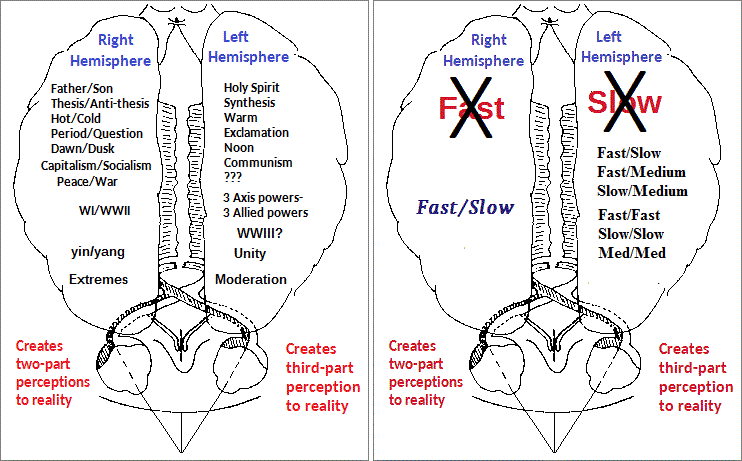
Whereas the fast/slow model of the book is fine if we accept that the human brain is of a binary design, which would somehow lead one to think that such a pattern would be solely dominant in anatomy, genetics, etc... and not to mention where our biology would have come to be stationed at instead of the third planet from a source of solar energy; but if we think in terms of a trinary system such as that referenced by physics... (electrons- neutrons- protons, 3 quarks/3 anti-quarks, three families of fundamental particles... cast amongst various dichotomies of particle arrangements); then the dual process/thinking, fast/slow theories must be re-evaluated accordingly. Although I used a three-patterned reference of "fast/fast, slow/slow, medium/medium", the intent is to portray the possibility of three alternatives to the existing two-model scheme; and the introduction of the word "medium" into the mixture would present us with a situation we find amongst amino acids: base pairs in the midst of a triplet code if we were to include a fast/medium and slow/medium configuration into the mix... though the triple code suggests the presence of a 3-to-1 ratio when we differentiate the presence of Uracil for DNA and Thymine for RNA. In other words, both acids have the three (adenosine- cytosine- guanine), and a singular different one... not to mention the existence of three stop codons and one start codon. In retrospect, the "two" represents a pairing but that there is an overlapping three-patterned formula to be considered as a 3-to-1 ratio as a model that so many have not even begun to consider.
If thinking actually does (or will... someday, evolutionarily speaking) imitate the pattern we see on a genetic formulation of base pairs involved in a triplet code that can be viewed as a 3-to-1 ratio amidst a quantity of 64 amino acids with 3 stop and 1 start amino acids which reflects the ancient I-Ching 8 x 8 configuration; than the perspective of having a "dual processing brain" is akin to an antiquated mind-set that has yet to mature.
Incidentally, if we include a representation of an evolutionary integration and/or overlap where exchanges take place and may move through extremes as well as a middle-ground "resting" or idling state, the following might be of some general applicability. It is a third option set next to a fast...slow and {fast/slow} characterization:
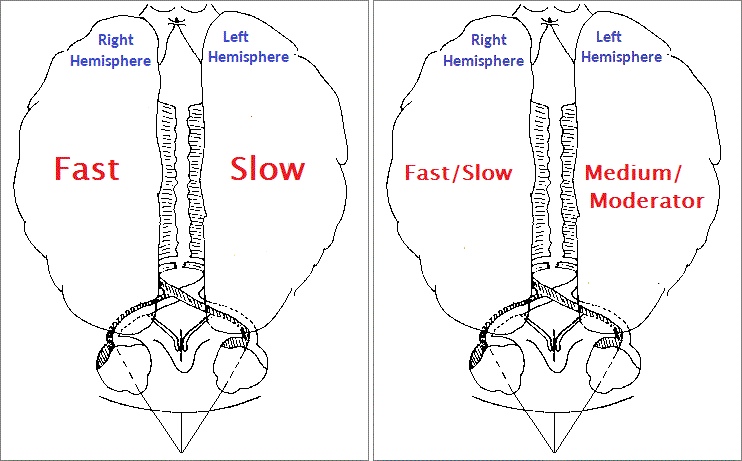 |
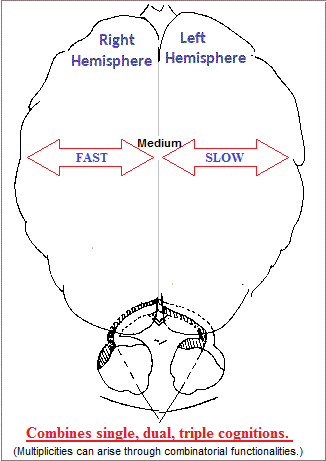 |
Because there are cultural differences with respect to the appearance and usage of particular numerically identifiable cognitive models (0,1,2,3,4,5,6,7,8,9,10, etc.,) patterns, we can not assume that the reference examples used in the book as instructive materials based on observations, conversations, experimentation, etc., taken in one or two areas of the globe are particularly illustrative of all humanity. This is a stretch of the imagination that all researchers want to avoid. This is western culture egotism. This is similar to claiming that atomic behavior is based on a duality simply because we focus on the concept of negative (electron) and positive (proton), without even looking for a neutrality (neutron)... just as people are not looking for a neutrality in the presence of a Peace/War (conflict) duality of perception.
Date of Origination: Monday, 26-Dec-2016... 08:09 AM
Date of initial posting: Monday, 02-Jan-2017... 10:33 AM
Updated posting: Saturday, 31-March-2018... 11:52 AM